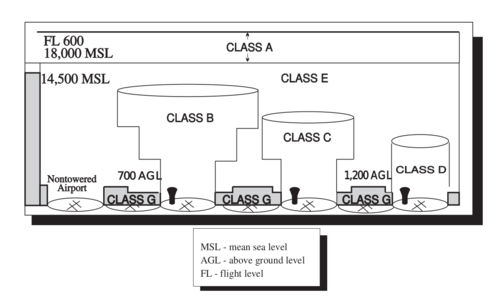Airspace
Airspace[1] is the portion of the atmosphere controlled by a country above its territory, including its territorial waters or, more generally, any specific three-dimensional portion of the atmosphere. It is not the same as aerospace, which is the general term for Earth's atmosphere and the outer space in its vicinity.
Within the United States:
- Controlled airspace[2] exists where it is deemed necessary that air traffic control has some form of positive executive control over aircraft flying in that airspace (however, air traffic control does not necessarily control traffic operating under visual flight rules (VFR)[3] within this airspace).
- Uncontrolled airspace[4] is airspace in which air traffic control does not have authority, although it may act in an advisory manner. Only Class G space is uncontrolled by the FAA, because it is not under the domain of the FAA. The US Supreme court determined that flight in the lower altitudes interferes with the landowner's domain.
Airspace may be further subdivided into a variety of areas and zones, including those where there are either restrictions on flying activities or complete prohibition of flying activities.

Horizontal boundary
By international law, the notion of a country's sovereign airspace corresponds with the maritime definition of territorial waters as being 12 nautical miles (22.2 km) out from a nation's coastline. Airspace not within any country's territorial limit is considered international, analogous to the "high seas" in maritime law. However, a country may, by international agreement, assume responsibility for controlling parts of international airspace, such as those over the oceans. For instance, the United States provides air traffic control services over a large part of the Pacific Ocean, even though the airspace is international.
Vertical boundary
There is no international agreement on the vertical extent of sovereign airspace (the boundary between outer space—which is not subject to national jurisdiction—and national airspace), with suggestions ranging from about 30 km (19 mi) (the extent of the highest aircraft and balloons) to about 160 km (99 mi) (the lowest extent of short-term stable orbits). The Fédération Aéronautique Internationale has established the Kármán line, at an altitude of 100 km (62 mi), as the boundary between the Earth's atmosphere and outer space, while the United States considers anyone who has flown above 50 miles (80 km) to be an astronaut; indeed descending space shuttles have flown closer than 80 km (50 mi) over other nations, such as Canada, without requesting permission first.[5] Nonetheless both the Kármán line and the U.S. definition are merely working benchmarks, without any real legal authority over matters of national sovereignty.
The boundary between public airspace and private air rights is defined by national or local law.
See also
References
- ^ AIM Chapter 3. Airspace
- ^ AIM Section 2. Controlled Airspace
- ^ Pilot/Controller Glossary - VISUAL FLIGHT RULES
- ^ AIM Section 3. Class G Airspace
- ^ White, Robert E. "'Space Weapons Ban: Thoughts on a New Treaty". Archived from the original on 15 May 2008. Retrieved 27 July 2007.
External links
- U.S. airspace, as described in the Aeronautical Information Manual
- AirSpace Technology
- Worldwide Soaring Turnpoint Exchange: Airspace (publicly contributed data)
- Airspace data in Google Earth Format (KML)
